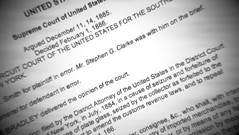The long-forgotten “mere evidence” rule
By Kristopher A. Nelson
in
April 2011
600 words / 3 min.
Tweet
Share
The “mere evidence” rule, forbidding searches for documents that were themselves not “instrumentalities” crimes (or contraband themselves) lasted well into the twentieth century before being abandoned. So why were telegrams never explicitly covered by the rule?
Please note that this post is from 2011. Evaluate with care and in light of later events.
In 1886, the Supreme Court in Boyd v. United States held that compelling production of business records as part of a customs proceeding violated the Fourth Amendment’s protections against unreasonable searches and seizure (and the Fifth’s, against self incrimination). A later ruling, Gouled v. United States (1921), solidified the “mere evidence” rule, forbidding warrants to search for documents that were themselves not “instrumentalities” or contraband. The rule, based on common-law principled discussed in Entick, lasted well into the twentieth century before being abandoned:
Purely evidentiary (but “nontestimonial”) materials, as well as contraband and fruits and instrumentalities of crime, may now be searched for and seized under proper circumstances. (See Warden v. Hayden, 1967).
Business and computer records, whether on paper or not, are seizable, even if they themselves are not illegal. Antonin Scalia, a strong proponent of originalist understandings of the Constitution, has been supportive a flexible interpretation of the Fourth Amendment–but what if Boyd was right?
If it should turn out that Boyd v. United States correctly read the original understanding, originalist justices would be required to rethink a hugely important body of modern law–the one authorizing seizure or subpoena of business records, including computer records. (See Reconstructing the Fourth Amendment: A History of Search and Seizure)
The goal of the “mere evidence” rule was to protect privacy, and was based on property rights–the government had right to contraband or stolen property, but not to an individuals private papers:
[O]ne primary purpose was to protect the citizen’s privacy. Entick repeatedly excoriated the violation of privacy involved in examining a person’s secret papers. Boyd stressed that the principles of Entick were designed to protect the “privacies of life.” In Zurcher v. United States, Justice Stevens stated, “[t]he practical effect of the rule prohibiting the issuance of warrants to search for mere evidence was to narrowly limit . . . the character of the privacy interests that might be affected by an unannounced police search.” In short, although the scope of the mere evidence rule was defined in terms drawn from property law, a major purpose of the rule was to protect personal privacy by limiting the government’s authority to search. (Russell W. Galloway, Jr., The Intruding Eye: A Status Report on the Constitutional Ban against Paper Searches, 1982)
The Supreme Court in the 1960s moved away from this property-based understanding of the Fourth Amendment in cases like Katz and Hayden to one focused on people. This shift had the twin effects of granting Fourth Amendment protections to telephone conversations while also opening up the seizure of “mere evidence.”
Since I am currently research telegrams and the Fourth Amendment, I have to wonder why they did not receive this protection. After all, since telegrams were generally seized as evidence to prove a crime (and not as illegal items themselves), they clearly fall in the category of “mere evidence.” So why are there examples of their seizure contrary to this understanding? Why were other kinds of papers protected from seizure by the rule, while telegrams were not? Why did postal mail receive exactly this explicit protection in Boyd, but no court did the same for telegrams?
Related articles
- The Fourth Amendment: from property to people (inpropriapersona.com)
- An argument for the “Inviolability of Telegraphic Correspondence” (inpropriapersona.com)

